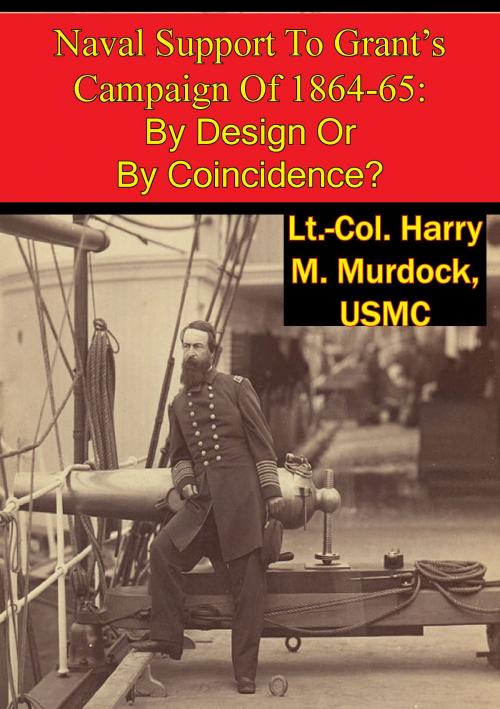Naval Support To Grant’s Campaign Of 1864-65: By Design Or By Coincidence?
Nonfiction, History, Modern, 19th Century, Americas, United States, Civil War Period (1850-1877), Military| Author: | Lt.-Col. Harry M. Murdock USMC | ISBN: | 9781786253804 |
| Publisher: | Golden Springs Publishing | Publication: | November 6, 2015 |
| Imprint: | Golden Springs Publishing | Language: | English |
| Author: | Lt.-Col. Harry M. Murdock USMC |
| ISBN: | 9781786253804 |
| Publisher: | Golden Springs Publishing |
| Publication: | November 6, 2015 |
| Imprint: | Golden Springs Publishing |
| Language: | English |
By 1863, the Civil War was basically a stalemate between the two belligerents. Though the Union forces had achieved some success in conducting joint expeditions that resulted in securing the Mississippi River and the majority of the Southern ports, the major land armies of the Union were generally ineffective. In March 1864, General Ulysses S. Grant was named General-in-Chief of the Union army; he designed a campaign for future operations that called for synchronized operations by the Union armies supported by the Union navy. This monograph examines the naval support to Grant’s campaign to determine whether or not the provided support was by design or just coincidence.
The monograph initially establishes the theater of war setting that Grant inherited when he assumed the billet of General-in-Chief. This is followed by a summary of the campaign from a naval perspective. The monograph concludes with an analysis of the naval support provided to the campaign using the four components of a successful campaign espoused in Lieutenant Colonel James Dubik’s “A Guide to the Study of Operational Art and Campaign Design.”
Based on the analysis, it is evident that the naval support was provided by design. Grant demonstrated an extraordinary ability to visualize operations in the entire theater of war. He fully understood and appreciated the usefulness of the sea dimension and exploited its use. The Union navy’s command of the seas and resourcefulness allowed Grant to maintain his freedom of action, to operate from secure bases of operation, and to destroy the South’s capacity to wage war.
By 1863, the Civil War was basically a stalemate between the two belligerents. Though the Union forces had achieved some success in conducting joint expeditions that resulted in securing the Mississippi River and the majority of the Southern ports, the major land armies of the Union were generally ineffective. In March 1864, General Ulysses S. Grant was named General-in-Chief of the Union army; he designed a campaign for future operations that called for synchronized operations by the Union armies supported by the Union navy. This monograph examines the naval support to Grant’s campaign to determine whether or not the provided support was by design or just coincidence.
The monograph initially establishes the theater of war setting that Grant inherited when he assumed the billet of General-in-Chief. This is followed by a summary of the campaign from a naval perspective. The monograph concludes with an analysis of the naval support provided to the campaign using the four components of a successful campaign espoused in Lieutenant Colonel James Dubik’s “A Guide to the Study of Operational Art and Campaign Design.”
Based on the analysis, it is evident that the naval support was provided by design. Grant demonstrated an extraordinary ability to visualize operations in the entire theater of war. He fully understood and appreciated the usefulness of the sea dimension and exploited its use. The Union navy’s command of the seas and resourcefulness allowed Grant to maintain his freedom of action, to operate from secure bases of operation, and to destroy the South’s capacity to wage war.



![Cover of the book Staff Ride Guide - The Battle Of First Bull Run [Illustrated Edition] by Lt.-Col. Harry M. Murdock USMC](https://www.kuoky.com/images/2014/august/300x300/9781782894599-MCut_300x.jpg)


![Cover of the book A Soldier's Recollections [Illustrated Edition] by Lt.-Col. Harry M. Murdock USMC](https://www.kuoky.com/images/2013/february/300x300/9781908902771-kO4t_300x.jpg)
![Cover of the book The Overland Campaign, 4 May-15 June 1864 [Illustrated Edition] by Lt.-Col. Harry M. Murdock USMC](https://www.kuoky.com/images/2015/november/300x300/9781786254368-twUA_300x.jpg)




![Cover of the book Four Years Under Marse Robert [Illustrated Edition] by Lt.-Col. Harry M. Murdock USMC](https://www.kuoky.com/images/2015/november/300x300/9781786251169-Rry8_300x.jpg)


